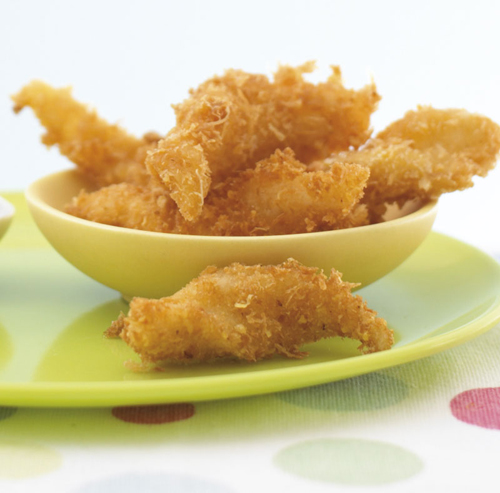As your toddler grows older and her social net widens, she’ll begin to make her own friends, and undoubtedly be influenced by them! Parties, too, may be a more frequent occurrence in your child’s life. With a little creativity, you can continue to offer nutritious, delicious food, and broaden your child’s palate in the process.
| Q: |
My child is starting to have friends around for lunch; do you have any good ideas for toddler-friendly meals?
| | A: |
Most little ones won’t want to spend a lot of time at the table,
and will want to eat their food quickly and get on with the fun. It
makes sense, therefore, to offer small, manageable portions of food that
look fun to eat.
Pasta is always popular with little ones—spoon a hidden vegetable sauce on top or add chicken meatballs.
For kids at the older end of this age group, you can make a little
pasta “bar” with some grated cheese, cooked peas, corn, little
meatballs, diced chicken, tuna, olives, and tomato sauce so that they
can create their own pasta masterpieces.
Other good ideas are platters of toddler-sized sandwiches with fruit and some mini-muffins or fruit and oat bars, mini-meat or fish balls (see Chicken meatballs), mini-burgers, marinated chicken skewers ,
individual fish or shepherd’s pies, or even a baked potato with one of
any number of toppings. Little quiches or mini-pizzas make a nice treat too.
It can sometimes be
difficult to encourage fussier eaters to eat their vegetables, but
supplying crudités with a tasty dip alongside is a solution.
|
| Q: |
Should I call parents to check that visitors don’t have food allergies?
| | A: |
In reality, it’s up to the parents of allergic children to
contact you if there are problems with food, and even send their own if
there is potential for a reaction. However, if you are having a child
around for the first time, it’s best to check. Some parents might just
assume that everyone knows their child is allergic, and forget to
mention it.
|
| Q: |
How can my child explain to her friends that she doesn’t eat meat?
| | A: |
I would suggest that she doesn’t need to do this herself, and
that you can advise parents or carers of this fact in advance. There are
plenty of child-friendly meals that do not include meat, including
pastas, salads, sandwiches, and soups. If the adults are aware of your
child’s diet, they can make the appropriate choices without any need for
explanation.
If your child does
find that she’s in the position of having to refuse something because it
is meat or it contains meat, you can encourage her to explain that she
either doesn’t “like” meat, or that her family doesn’t “eat” it. Most
young children aren’t self-conscious enough to mind saying that they
like, or don’t eat, different things.
Your child may slip up
and eat meat on the odd occasion, and even start to demand it—whether or
not you allow this is your choice. But if you are staunch about your
vegetarian beliefs, then simply explain to your child that you have
different eating habits in your family.
When you invite her
friends over, avoid offering anything that might put off the average
toddler. Stick to a vegetarian meal that most children would eat at
home, such as pasta with tomato sauce.
|
| Q: |
My child’s third birthday is coming up—do you have any ideas for healthy party foods?
| | A: |
Traditional birthday party food doesn’t have to be unhealthy, and
you can create delicious cakes, muffins, and cookies using honey,
molasses, and brown sugar to sweeten them, or add grated carrots,
zucchini, apples, or pears to make them moist and nutritious.
Pretty, tiny, and
brightly colored are the order of the day, and you’ll be a step closer
to getting them to eat what you want. Platters of fresh fruit with a
little chocolate sauce for dipping are fun, as are bite-sized pieces of
fruit threaded onto a straw. Little pizzas with faces on English muffins
or mini-pitas can “hide” quite a few veggies in the toppings.
Fresh fruit popsicles are perfect for outside parties. Smoothies offered in tiny shot glasses are ideal for offering a boost of nutrition, and some much needed fluid.
One-bite sandwich squares are most appealing to little ones, as are mini-bagels. For filling ideas, see Sandwiches for Toddlers.
Create tiny salads inside a baby lettuce leaf, with just enough for one
or two bites. Breadsticks with hummus, cheese straws, and chunks of
cheese are always popular.
|

Did you know…
that you can make healthy versions of more traditional kids’ foods? Serve fish goujons or chicken fingers rather than “nuggets,” mini-burgers, and pasta with tomato sauce.
Although your little one may express interest in the less-healthy foods
that his friends eat, the trick is to never give in. If you always
offer healthy, nutritious food, he’ll develop a taste for them, and see
them as familiar.

|